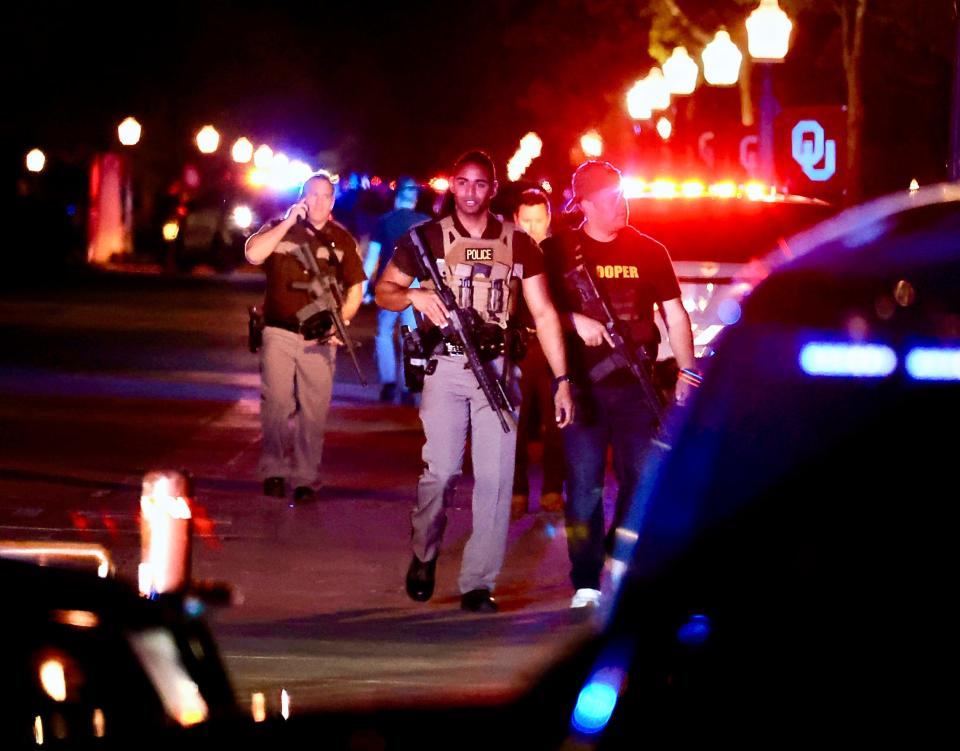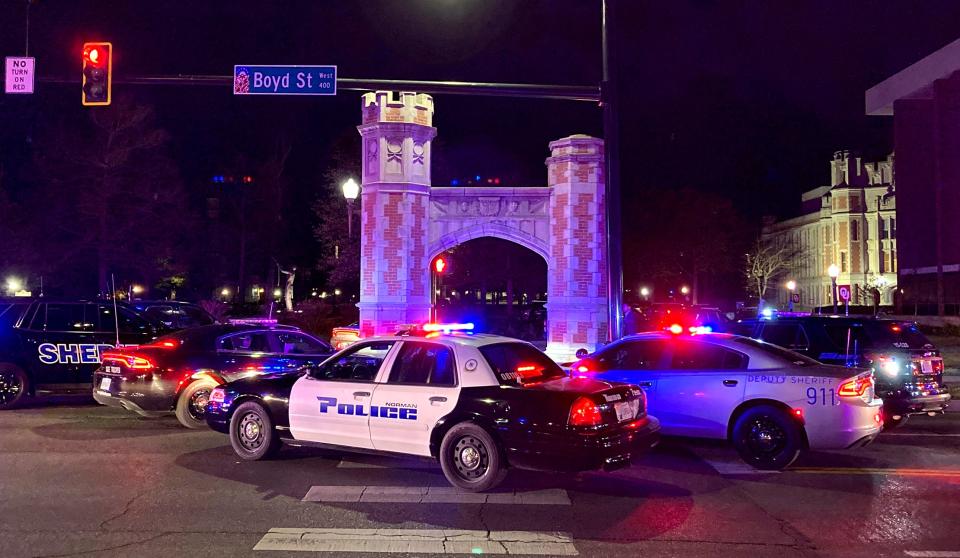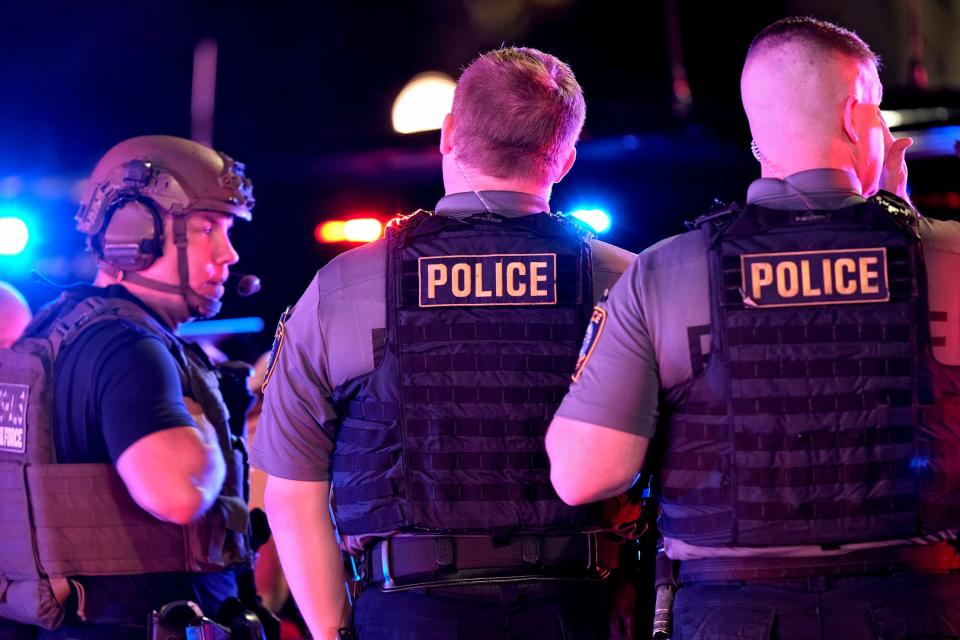University of Oklahoma says fake calls reporting active shooter came from outside US
NORMAN — Fake 911 calls originating from outside the United States prompted a massive police presence at the University of Oklahoma on Friday night. The calls falsely reported there was an active shooter on OU's campus.
OU President Joseph Harroz Jr. said late Sunday the university worked with the FBI to determine the false alarm was created by "swatting" calls.
Swatting is a prank where someone makes a hoax 911 call while disguising their phone number and its origin, drawing police and often heavily armed SWAT officers to the location of a made-up emergency.
Harroz sent an email to university students and staff late Sunday.

"Although the investigation will continue for some time, it is believed that the calls targeting our campus originated from outside of the United States," Harroz said in the email.
"Sadly, OU is not the only school to have recently been targeted by swatting, and it is deeply troubling there are people who want to purposely inflict such trauma and chaos."
OU swatting event Friday managed
An all-clear was given Friday night 89 minutes after the university alerted students and staff of a reported active shooter on campus. In a tweet, the university said campus police issued an "all clear" after a thorough search revealed no threat was found.
Nate Tarver, chief of the University of Oklahoma's police department, told media representatives at the scene Friday the hundreds of officers who responded to the panic call could not find any evidence that a shooting had occurred.
"We did a thorough search of the library and the adjacent area, and found no threats, no evidence that any shooting had occurred," Tarver said.
The chief said his officers have been trained to respond to active shooter situations and will review the response to determine if there are any areas where it could be strengthened. Beyond that, he said the department's staff was happy that it appeared everyone was safe.
"... I want to express my overwhelming gratitude to the OU Police Department, to the OU Department of Campus Safety, and to the more than 100 officers from multiple law enforcement agencies who immediately and decisively took action, heading directly toward the perceived threat without an ounce of hesitation," Harroz wrote Sunday.
Similar swatting events on the rise nationwide
On Sunday, Boston University was a target of a similar swatting call.
Boston University Police said that, although officers were still investigating, the department was “confident” there was no threat to the community in an update just before 8:50 p.m. on Sunday.
“We greatly appreciate your cooperation,” BU Police told Boston.com. “Hoax ‘swatting’ calls have been occurring nationally and cause a great deal of anxiety to the community.”
These types of calls have been increasing at schools and universities, reports The Associated Press.
Hundreds of cases of swatting occur annually, with some using caller ID spoofing to disguise their number. The goal is to get authorities, particularly a SWAT team, to respond to an address.
Do fake threats hinder response to real shootings?
Authorities are grappling with false alarms in a country where mass shooters have killed hundreds of people throughout history. Shooters have attacked in places like stores, theaters and workplaces, but it is in schools and colleges where the carnage reverberates perhaps most keenly.
At U.S. schools and colleges, 175 people have been killed in 15 mass shootings that resulted in the deaths of four or more people, not including the perpetrator — from 1999′s Columbine High School massacre to March's shooting in Nashville, Tennessee. That’s according to a database compiled by The Associated Press, USA Today and Northeastern University, in addition to other AP reporting.
Do false threats pose a risk?
Swatting calls have proven dangerous — even deadly — in some situations.
In 2017, a police officer in Wichita, Kansas, shot and killed a man while responding to a hoax emergency call. Just last month, the city agreed to pay $5 million to settle a lawsuit, with the money to go to the two children of 28-year-old Andrew Finch.
The hoax call that led to his death began as a feud between two online gamers. One of the gamers recruited Tyler Barriss to “swat” the other gamer. But the address used was old, leading police to Finch, who was not involved in the dispute or playing the video game.
Barriss was sentenced to 20 years in federal prison, while the other two gamers were sentenced to 15- and 18-month terms.
Police in Maryland also shot a 20-year-old Maryland man in the face with rubber bullets after a fake hostage situation was reported at his home.
The FBI in Pittsburgh nodded to the risk, noting in a statement about the school threat cases that it “takes swatting very seriously because it puts innocent people at risk.”
Heather Hollingsworth, Peter Smith, Ron Todt, Marc Levy, and Lindsay Whitehurst from the Associated Press contributed to this report.
OU President Joseph Harroz Jr.'s letter to students, staff
Here is the full text of the email Harroz sent to OU students and staff late Sunday:
April 9, 2023
Dear OU Family,
I write to provide an update of what we have learned about the incident that impacted our Norman campus Friday night, which turned out to be false reports of an active shooter. We have since learned more information about what occurred, and I want our community to be the first to know.
First, and above all else, we are enormously relieved that the situation turned out to not be a real event and that our community and our campus are safe. Just as important, I want to express my overwhelming gratitude to the OU Police Department, to the OU Department of Campus Safety, and to the more than 100 officers from multiple law enforcement agencies who immediately and decisively took action, heading directly toward the perceived threat without an ounce of hesitation. Within less than one minute of the initial call to 911, the first emergency RAVE alert was sent to all Norman students, faculty, and staff, and OUPD arrived on the scene in under two minutes. In addition, there were many other staff and administrators who did their part Friday night to keep our community safe and informed. The level of professionalism that was demonstrated across the board is indicative of the quality of our team and the hard work and discipline that are poured into training for such an event. I’m also profoundly thankful to every student, faculty, and staff member who took our emergency alerts seriously and remained vigilant as the situation unfolded. As with any major event, we will learn from this and find ways to improve, but the main takeaway is that our community and its response were exceptional.

We now know more about Friday’s incident. At approximately 9:24 p.m., several calls were made to 911 reporting an active shooter on campus near the South Oval and Bizzell Memorial Library. Officers immediately responded to the area, and after conducting a thorough search, did not find any evidence of a shooting or criminal activity. With assistance from the FBI, we have since confirmed that this was a “swatting” incident, where callers fake an emergency that draws a large response from law enforcement. Although the investigation will continue for some time, it is believed that the calls targeting our campus originated from outside of the United States. Sadly, OU is not the only school to have recently been targeted by swatting, and it is deeply troubling that there are people who want to purposely inflict such trauma and chaos.
As relieved as we are that the incident turned out to be false, we recognize that the feelings of fear and anxiety that many of us experienced on Friday were very real. Please remember that resources are available to you through the university. If you are experiencing difficulty, please contact your campus counseling services (Norman, Health Sciences Center, OU-Tulsa).If you are a student, please feel free to reach out to a student life or centralized student affairs team member at your respective campus. Faculty and staff may also seek assistance through our Employee Assistance Program (EAP).

Now is also a good time to remember that you can update or verify your contact information for OU emergency communication alerts by visiting ecs.ou.edu. On this page, you can also edit your contact settings to add a second phone number – such as that of a family member or loved one – to receive these alerts. In addition, anyone who is not an OU student or employee may opt in to receive emergency alerts for any of OU’s three campuses. To opt in on the Norman campus, text “OUALERTS” to 67283; Health Sciences Center, text “HSCAFFILIATE” to 226787; and OU-Tulsa, text “outulsa” to 67283.
I again share my gratitude to all of you. As always, I am humbled and honored to be a part of this remarkably caring community.
With appreciation,
Joseph Harroz, Jr.
President
This article originally appeared on Oklahoman: OU says fake active shooter calls came from outside the US

